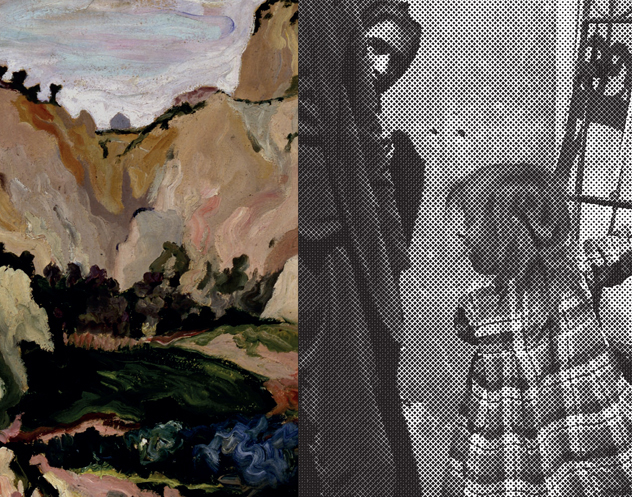CARLO LEVI: ALL THE HONEY IS GONE. SARDINIA, PAINTING
edited by Giorgina Bertolino
and the special productive residence project of
VITTORIA SODDU
EVERY GOING IS A RETURN
made with the Sardinia Film Commission Foundation
open day: Friday 11 February 2022, h. 10 – 19
opening: 11 February – 19 June 2022
The MAN Museum of Art Province of Nuoro presents from Friday 11 February to Sunday 19 June 2022 the great anthology Of Carlo Levi (Turin 1902 – Rome 1975) which pays homage to the painter-writer Nei 120 from birth, on the occasion of the anniversaries of his two trips to Sardinia, completed in May 1952 and December 1962. The exhibition documents the entire span of his research with 89 works among paintings, drawings and engravings, dated from 1925 to the early seventies . It makes use of the collaboration of Carlo Levi Foundation of Rome and loans from museums, public and private collections. It is enriched by the special productive residency project which involved the artist Vittoria Soddu (Sassari 1986) with a triple intervention created with the production of Fondazione Sardegna Film Commission, conceived specifically for the exhibition itinerary.
The exhibition takes its title from All the honey is gone , Carlo Levi’s book on Sardinia published by Einaudi in 1964. The book is the story of the trips of 1952 and 1962, and is a palimpsest of natural, cultural, poetic and political landscapes. The MAN exhibition reconstructs the encounter between the artist and the island, offering the opportunity to immerse oneself in his painting, from his beginnings to his maturity. Carlo Levi: all the honey is finished. Sardinia, painting it is, at the same time, a monographic exhibition and a large anthology, spread over the three floors of the Museum. Dedicated to a protagonist of twentieth-century Italian history and culture, it is an invitation to rethink his legacy in the present.
“The exhibition that the MAN of Nuoro dedicated to Carlo Levi on the one hundred and twentieth anniversary of his birth investigates lesser-known aspects of his artistic and intellectual history, in line with a desire for research that the museum has dedicated in recent years to the rediscovery of its territory – the insular world of the Italian Mediterranean – through the contributions of artists of different origins and nationalities who have dedicated a significant part of their research to Sardinia, in a path that from the recent past reaches up to the work of the younger generations”, explains Luigi Fassi in the introduction to the exhibition catalogue.
Sardinia
The first rooms on the ground floor of the Museum introduce the artist with three self-portraits (including the famous Self-portrait with yellow hand of 1930) and tell of his travels in Sardinia. Carlo Levi arrived on the island for the first time in May 1952 and returned in December ten years later. His reports are published in installments in “L’Illustrazione Italiana” and in “La Stampa”, then collected in All the honey is gone in 1964. The words are intertwined with the images, recalled in the exhibition by over 30 photographs that recompose the landscapes of Sardinia in the 1950s. Different perspectives and lenses, between amateur snapshots and art photographs, convey the charm of the island, its cities, its people, its nature and its history, beyond the more usual itineraries.
A group of 10 photographs is exhibited for the first time of the unpublished Travel Album by Carlo Levi from 1952. Preserved in the photographic collection of the Levi Foundation in Rome, the small black and white prints of the Album constituted the starting point of the research underlying the exhibition. These precious materials, arranged on the noticeboard together with books and documents, are flanked on the wall by the photographic campaigns of two famous authors: 16 photographs Of Federico Patellani (Monza 1911 – Milan 1977), taken in Sardinia in 1950 – on loan from the Museum of Contemporary Photography of Milan-Cinisello Balsamo – partly published in conjunction with Trip to Sardinia , Levi’s first article to appear in “L’Illustrazione Italiana” in June 1952; 10 photographs of Hungarian János Reismann (Szombathely 1905 – Budapest 1976) from 1959 – on loan from the Hungarian Museum of Photography in Kecskemèt – published in the German version ofAll the honey is gone (Aller Honig geht zu Ende. Tagebuch aus Sardinien) published in 1965.
Introducing All the honey is gone in 1964, Carlo Levi he compared his book to a portrait: “Thus, this writing, which is neither an essay, nor an investigation, nor a novel, but a simple, lateral chapter of that present history that we all live, or write, within ourselves and outside of ourselves, seems to me to be similar rather to a portrait, to an attempt, only hinted at and partial, of a portrait of a person known over time, whose face tells and understands, today, the different moments of his history. Is this person only Sardinia?”.
As the curator explains, Giorgina Bertolino “the exhibition project begins with the rereading of All the honey is gone, a written landscape that involves and implies the artist’s body, the physical experience on the ground, the contact with a past blended with the soil of the present, listening to the sounds, songs and voices of the people. All the honey is gone it is a landscape-book, of the sort of those readings that today we gather around the capacious notions of landscape anthropology and cultural ecology. Beyond the idea of a pacified landscape, crystallized by the rhetoric of beauty, Carlo Levi’s Sardinian landscapes retain their dynamic, cognitive and political capacity intact”.
Painting
The anthology retraces the seasons of Carlo Levi’s painting, starting from his beginnings. On the first floor, paintings dating from 1925 to 1930 show the cities of the young Levi: Turin, where he was born, Paris and Alassio, in Liguria, where his family owns a house on the hill: this is where it is set Air, a painting from 1929 belonging to the collections of the GAM, Galleria Civica d’Arte Moderna e Contemporanea of Turin. The paintings document his education European artist and the intense dialogue with French art; recompose the family circle (with Father at the table of 1926, Extrusion figure of 1929 and Two ladies of 1930, on loan from the Levi Foundation) and the field of friendships.
The works on the second floor retrace the following seasons, from the early thirties to the seventies, following the evolution of “wavy handwriting”, the unmistakable stylistic signature that animates self-portraits and portraits (this is the case of Leone Ginzburg of 1933), the landscapes (the Landscape of Alassio of the Museo Novecento in Florence) and the still lifes (Still life with French bread of the artistic heritage of the Unipol Group).
Carlo Levi’s painting is a diary, a biography : his works talk about the confinement in Lucania (with The road to the caves of 1935, The Bersagliere pit And The Santarcangelese of 1936, on loan from the National Museum of Matera, Palazzo Lanfranchi); they tell of the war, of the Liberation (with theSelf-portrait of 1945 of the National Gallery of Modern and Contemporary Art in Rome) and thus of meetings, of loved ones (Portrait of Linuccia Saba, 1944-1945, RAI Collection, Friuli Venezia-Giulia regional headquarters in Trieste) of the places, houses, gardens, trees, depicted in the cycle of Carobs of the early seventies. For Carlo Levi, everything is portrait: the canonical genre of art history is for him an affective and empathetic tool of knowledge.
The room that closes the anthology presents, for the first time in Italy , 12 cards belonging to the cycle of blindness, a group of drawings from 1973 made in parallel with the writing of Gate notebook , published after his death. In these drawings born from the darkness, while he is recovering from an eye operation, Carlo Levi immerses himself in the depths of the unconscious and of memory, exploring his own imagination.
Vittoria Soddu: every going is a returning
The special project by Vittoria Soddu (Sassari 1986) is a rereading in the present of All the honey is gone , a contemplative landscape practice inspired by the narrative of Carlo Levi. It takes the title from a sentence at the opening of the book: “Here in the contemporary world the cards have been shuffled; here on the island of the Sardinians every going is a return”.
The project consists of three works conceived specifically for the exhibition . The journey begins with the watercolor stroke that animates the metamorphosis of the woman into a crow in the video installation Back to back . The video, in one of the rooms on the ground floor, anticipates the echo of the story suggested in the soundtrack Orune on the second floor, a reworking of archive materials with the voice of Levi himself and field recordings. On the third floor, the most choral work: Every going is a returning returns in a filmic form, with a strong performative matrix, the reading of Levi’s work in dialogue with the territory and its community today.
Carlo Levi’s book tells the story Vittoria Soddu ,“It invites us to travel through concentric centers, accompanying us from one end of the island to the other, sometimes superimposing events and sensations. It is a text that leads us not to seek a rigid consequentiality of events; to access its labyrinthine essence it is necessary to accept this impossibility of tracing a logical narrative, with its own crystalline chronology”.
“The choice of Vittoria Soddu, an artist who works in the hybrid field between performance, moving image and sound sculpture, is guided by a more experimental approach to connecting with the public. Our production team placed itself at the service of the creative path of such an innovative artist according to a principle of juxtaposition, overlap and contamination of different languages. A challenge for future formats, to be experimented with new viewers and new platforms, creating together a new vision of Sardinia”, explains Gianluca Aste , president of the Sardinia Film Commission Foundation.
The exhibition is accompanied by an important catalog published by MAN with the Allemandi Publishing Company . Introduced by Luigi Fassi, the volume offers a large iconographic set with the color plates of the 89 works on display in the exhibition, the photographs from Carlo Levi’s travel album, the black and whites of Federico Patellani and János Reismann and period documents . The rich section of texts delves into the relationship between Levi and Sardinia, with a selected anthology of his first articles and through the critical essays by Giorgina Bertolino, Francesca Congiu, Valeria Deplano, Elisabetta Masala and the conversation between Vittoria Soddu and Nevina Satta, Micaela Deiana, Marco Piredda of the Sardinia Film Commission Foundation.
CONTACTS FOR THE PRESS
+39.0784.252110
https://drive.google.com/drive/folders/1gQ9Kr2SgfglQfmGE8IkOfuUkMwSNNDjd?usp=sharing


